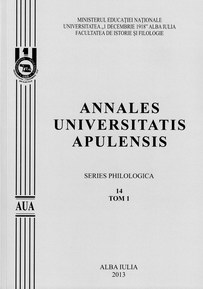Substratul metaforic în poezia ortodoxist-gândiristă a lui Ion Pillat
The Metaphoric Substrate in the "Ortodoxist-Gândirist" Poetry of Ion Pillat
Author(s): Dănuța Magdalena PruneanuSubject(s): Literary Texts
Published by: Universitatea »1 Decembrie 1918« Alba Iulia
Keywords: Gândirea; metaphor; religious; orthodoxist; symbol
Summary/Abstract: „Painter of Arges territory”, Ion Pillat is the writer who, along with Lucian Blaga, Adrian Maniu, Aron Cotruş and Nichifor Crainic, outlined the first pages of a new poetry in „Gândirea”, different in terms of expansiveness and poetic structure. Framed by the authentic traditionalism, the two volumes, „Pe Argeş în sus” (1923) and „Satul meu” (1925), reveal ethnic features of the local space. The pillatian parnassians confer the poetry the distinctive impersonal structure, different from that of French poetry, implementing „the seal of a classic, balanced, full of Mediterranean light soul”. Ion Pillat’s poetry is characterized by interposing between the Arges cultural space and Miorcani Arges steppe, from where the „În vie” poem resulted, having as a background the beneficial fragrance of vineyard and orchards. It was published in „Gândirea” magazine. Religiosity poetry Ion Pillat stands, particularly in human substrate, characterized by the absence of conventionalism as a source of argument and subtlety of his poetry where verses occupies an important place in the old church volume published between 1923 and 1926. The religious, partly metaphorical, substratum reinforces not only the excessive reverence, but especially the sweetness of the native lands with the interpenetrations of the bows to the hermitage, of the Holy Book in the monastery, where the chop is heard in „the old church”. From somewhere deep inside echoes of the past from Cozia monastery answer in „Olt undulations”. „Biserica de altădată” is also a „pillatian” poetic art with an eponymous title that gives the volume the reference to a religious text. The return to the past makes the difference between the traditionalist sense of Nichifor Crainic and that of Ion Pillat and determines the intention to autochthonize the biblical legend: „Biserica de altădată, ce ctitor mi te-a scos în cale / Cu zarzării din curtea veche şi năpădită de urzici, / Sub coperiş lăsat pe-o rână, la margine de mahalale, / Sub turnul mângâiat în aripi de raze şi de rândunici”... (Biserica de altădată). The artistic concern is not to discover in the grammar of the church metaphor a broader context with reference to dogma and exegesis, he lives rooted in the native space with parental home, where the tombs and the church are breaking the melancholy and the sorrow for the passing of time. The symbolism of the transit is found in „Biserica de altădată” by recalling the time and rediscovering the past values by the synesthezic metaphor of sleep combined with the sacred space. The state of solitude pours in the melancholic topos of the irreversibility of time, „the deep and immutable bottom of the ancestral beliefs, hidden - like an adapted pagan painting but in a Christian sense – in a great mythological building, whose traces have broken through to the present day and whose skeleton new beliefs and passions were added, coming through outside influences”. Monastic life is an excuse for meditation on the territ
Journal: Annales Universitatis Apulensis. Series Philologica
- Issue Year: 14/2013
- Issue No: 1
- Page Range: 188-194
- Page Count: 7
- Language: Romanian

